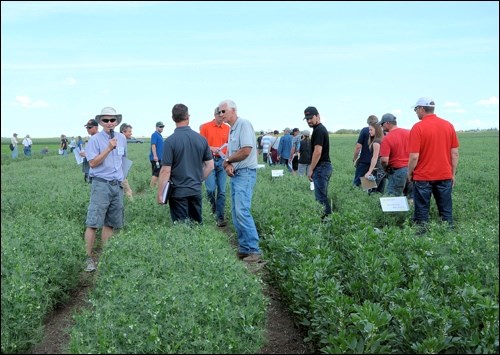SCOTT — They came from Rosetown, Biggar, Melfort, Battleford, Lloydminster, Birch Hills, Glaslyn, Kindersley, Medstead, Dundurn, Unity, Wynyard and many other places, including of course Wilkie. It was the 2015 Scott Research Farm Field Day and producers and agriculture industry specialists were there to learn and make connections.
This year the focus was on pulses.
Sherrilyn Phelps, Sask Pulse Growers agronomy and seed program manager, spoke about a relatively new crop in Saskatchewan, faba beans. Because of the amount of root rot in peas and lentils in recent years in Saskatchewan, pulse growers were looking for some alternatives. At the same time, faba bean markets were looking for new suppliers.
For those unfamiliar with faba beans, wikipedia.com summarizes, “Vicia faba, also known as the broad bean, fava bean, faba bean, field bean, bell bean or tic bean, is a species of bean native to North Africa, southwest and south Asia and extensively cultivated elsewhere.”
There are three potential markets. Large-seeded fabas are used extensively for food world wide, particularly in Egypt. Smaller seeded fabas, with less tannin in the skin, are used for livestock feed. A new, developing market is protein fractionation. Faba bean protein has less taste than pea protein.
According to Phelps, faba beans can be sown early, as early as early- to mid-April. It is frost tolerant and, even if new growth is frozen, the plants will regrow from the ground up. It is also a relatively easy crop to harvest as it can be straight cut and threshes smoothly.
Diseases and insects have not been big problems for faba beans in Saskatchewan to date, although the plant is sensitive to residual herbicides and in some cases producers need to wait as long as two years to plant faba beans after using certain herbicides in a field.
After Phelps had covered off the basics of faba bean agronomy, Gazali Issah, Western Applied Research Corporation research manager, discussed some of the faba bean trials being conducted at the Agriculture and Agri-Food Canada research farm at Scott, as well as at five other test sites. Experiments included fungicide applications, seeding rates and inoculant application, which tested 16 different options on two different varieties.
With faba beans being “the highest nitrogen fixing pulse crop we have,” Phelps expects this crop option to find a place in the rotation for some producers.
The faba bean presentation was followed by a look at some 30 pea varieties being grown at Scott and multiple other Saskatchewan locations. Tom Warkentin, a professor and plant breeder from the University of Saskatchewan, said the varieties in the plots surrounding him had already gone through breeding and co-op trials and had been registered. Now their performance in different areas of the province is being studied.
Warkentin explained some wild varieties of peas from other areas of the world are used in breeding programs for certain desirable characteristics, such as disease resistance. This year, he noted, many of the peas surrounding him as he spoke had quit flowering already, not using the full growing season to mature. Types of peas that could continue to flower despite hot, dry weather could add 10 to 15 per cent to yield at the end of the year.
Another characteristic to breed for is “stiffer stems” to help prevent lodging and make peas “easier to harvest.” Nutritional qualities are also important. They are working to develop peas with improved uptake of iron from the soil, with Warkentin pointing out that as much as one-third of the world’s population is deficient in the essential element.
Moving on to the soybean plots, Warkentine said the biggest challenge with soybeans — which is a huge crop on the global level — is that it is a warm season legume. Here we have about 100 to 120 growing days in a good year whereas soybeans require 110, 120 or 130 days. In addition, currently the earliest maturing soybeans have the lowest yield.
There were 36 varieties of soybeans in the field visited by the Scott Field Day attendees.
Other pulse crop presenters at the field day included Dan Ulrich on weed control in peas using Chateau and Eric Johnson, former AAFC officer in charge at Scott and now a research assistant at the U of S, tackling the question of “fall versus spring Pyroxasulfone in lentils.”
Experts also covered effects of boron application on canola, the effect of seed size and seeding rate on canola, plant growth regulators on wheat and barley and some aspects of soil and plant health, particularly the effects of Lignohumate and phosphorous.




